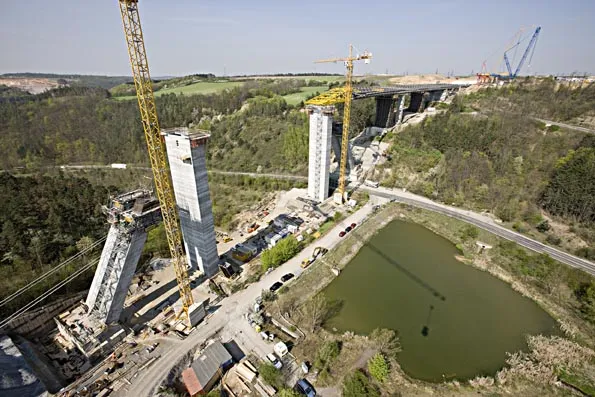As part of the R1 southern orbital motorway around the Czech capital, Prague, a joint venture is building a five-span, 461m long and approximately 65m high viaduct near the village of Lochkov, as a girder bridge construction. For the two steeply inclined twin piers, Doka has supplied an automatic climbing formwork solution that obviates the need for shoring and that will "cut more than 100 days from the construction period."
Cast-in-place concrete construction of bridge piers with such a steep inclination
July 17, 2012
Read time: 3 mins

As part of the R1 southern orbital motorway around the Czech capital, Prague, a joint venture is building a five-span, 461m long and approximately 65m high viaduct near the village of Lochkov, as a girder bridge construction.
For the two steeply inclined twin piers,203 Doka has supplied an automatic climbing formwork solution that obviates the need for shoring and that will "cut more than 100 days from the construction period."
Cast-in-place concrete construction of bridge piers with such a steep inclination usually requires a large volume of heavy falsework: there are not only vertical loads to be transferred but horizontal loads as well, and there has to be a standing space for the falsework on the valley floor which is capable of supporting the loads involved.
"No wonder, then, that when it came to planning the two twin piers of the Lochkov Bridge south of Prague, with their 57° inclination (33° from the vertical), the Doka Formwork experts' suggestion of using a self-climbing formwork solution was received by the JV with open ears," says Doka.
The rule is, says Doka, that when concreting inclined cross-sections, allowance must be made not only for the loads from the pouring operation but also for an inclination-dependent share of the concrete weight. This makes the statistical calculations more complex. On the Lochkov Bridge, the design of the twin piers provides for a precast intermediate slab, with in situ concrete topping, after every other 2.1m high casting section.
It was found that it would be possible to make use of this intermediate slab to relieve the self-climbing system of a significant part of the concrete weight by way of specially designed sets of inside formwork for the piers.
Made up of only around 142m² of Doka large-area formwork Top50, the four inside formwork units transfer the bulk of the additional loads into the lower casting sections. Their 4.2m height corresponds to two casting sections, meaning that the inside formwork only needs to be lifted and reset in every other climbing step, which saves crane time.
On each pier, the 2.1m high Top50 outside formwork is climbed by ten vertically parallel units of Doka climbing formwork SKE 50 with a load capacity of 5tonnes per bracket (four units on the forward-inclined side and six on the overhanging side).
For the two steeply inclined twin piers,
Cast-in-place concrete construction of bridge piers with such a steep inclination usually requires a large volume of heavy falsework: there are not only vertical loads to be transferred but horizontal loads as well, and there has to be a standing space for the falsework on the valley floor which is capable of supporting the loads involved.
"No wonder, then, that when it came to planning the two twin piers of the Lochkov Bridge south of Prague, with their 57° inclination (33° from the vertical), the Doka Formwork experts' suggestion of using a self-climbing formwork solution was received by the JV with open ears," says Doka.
The rule is, says Doka, that when concreting inclined cross-sections, allowance must be made not only for the loads from the pouring operation but also for an inclination-dependent share of the concrete weight. This makes the statistical calculations more complex. On the Lochkov Bridge, the design of the twin piers provides for a precast intermediate slab, with in situ concrete topping, after every other 2.1m high casting section.
It was found that it would be possible to make use of this intermediate slab to relieve the self-climbing system of a significant part of the concrete weight by way of specially designed sets of inside formwork for the piers.
Made up of only around 142m² of Doka large-area formwork Top50, the four inside formwork units transfer the bulk of the additional loads into the lower casting sections. Their 4.2m height corresponds to two casting sections, meaning that the inside formwork only needs to be lifted and reset in every other climbing step, which saves crane time.
On each pier, the 2.1m high Top50 outside formwork is climbed by ten vertically parallel units of Doka climbing formwork SKE 50 with a load capacity of 5tonnes per bracket (four units on the forward-inclined side and six on the overhanging side).









